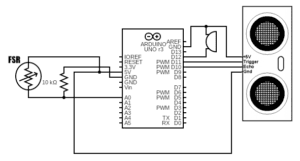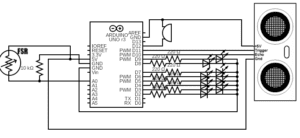For today’s recitation, I and my partner Nathalie White were asked to pick a sensor and build a circuit with it.
Out of the sensors those were listed in the recitation 3 document, I and my partner picked a sensor called “Ultrasonic Ranger”. The Ultrasonic Ranger has two parts, in which one is sending out the ultrasonic wave and another receiving the wave that it is sent out. The Ultrasonic Ranger, by sending out an ultrasonic wave and based on the time that wave hits the object and comes back to the sensor (there may be none if there is no object in the range), it is able to measure the distance between an object and the sensor itself. The range of available detection is from 2 centimeters to 4 meters.
According to the document which was attached at the recitation post, the formula for finding the distance is:
Test distance = duration × velocity_of_sound / 2
Here, duration would be the time which the ultrasonic wave to hit the object and came back to the sensor, and velocity_of_sound is set to 0.0340 cm/s (340m/s = 0.0340cm/s).
With this sensor, I and my partner decided to make an instrument which plays some note based on the distance.
We have based off our circuits from this site: https://www.instructables.com/id/How-to-Make-an-Arduino-Instrument/
In order to tell Arduino to play the note, we also used one force sensitive resistor.

This is the circuit diagram that we built first. With this circuit, we were able to play notes when we were pressing the force sensitive resistor.
For code, we first used the code from the site above. Please click here to be directed to my code. Check “Initial_Code.ino”.
This is me testing out our initial version.
However, we wanted to take a step further, and added an LEDs to the circuit. We made corresponding LED to turn on as we were playing the sound.

This is the circuit diagram with our modification. For code bit, please click here to be directed to my code. Check “Ultrasonic_withModification.ino”.
For modification, I first, added the pins for the LED, and here, to increase the efficiency of the code, I used for-loop. I also changed the notes, which could be get from the Arduino website. To initialize the mode the pins, I made the Arduino to turned off all the LEDs before turning it on, so that only the corresponding LED gets turned on.
I think there still is some space for improvement though. As you can see from the second video, two LED sometimes get lighted up. If I have time, I would love to try to fix this.
Question 1: What did you intend to assemble in the recitation exercise? If your sensor/actuator combination were to be used for pragmatic purposes, who would use it, why would they use it, and how could it be used?
As I described above, we were intending to assemble the instrument although the LED part sometimes is malfunctioning. I think our circuit is only touching the basis of the instrument, so I think we would have to work a lot before being able to use our instrument as a pragmatic purposes. If it were to be used for pragmatic purposes, musicians may use them. However, I think it would be better for children to use it because I think our instrument will be able to trigger curiosity of the children.
Question 2: Code is often compared to following a recipe or tutorial. Why do you think that is?
I think I am quite not understanding the question, but if the question is intending to ask why do I think code usually are referred to already made up codes, it is often too cumbersome to code everything. Although we can code everything so that our coding ability increase, I think we do not really have to code everything on our own as long as you know what the borrowed code does.
Question 3: In Language of New Media, Manovich describes the influence of computers on new media. In what ways do you believe the computer influences our human behaviors?
As I have mentioned in the documentation for recitation 2, our generation probably may be the generation that is first exposed to this large amount of technology. We are currently living amongst the computers because computers are everywhere. Although computer, in general, is influencing human in a good way that we are able to communicate with people who are on the other side of the Earth, easily being able to find information and so forth, I think computer is also influencing human in a bad way.
Cyber bullying and being anti-social has been a problem for a while. Because people are not seeing each other face to face, people tend to be more rough taking advantage of anonymity. Because people are just looking at their computer all day, people’s social ability tend to be degraded. In addition, people tend to become over dependent on the computers as even I get nervous when my phone or laptop is dying. In conclusion, I think there is two side to the computer being everywhere near us.
great work Lisa!
just one suggestion, for the code it would be better if you copy and paste it here or you create a github account and post them there instead of google drive, it would be easier to see it.
https://github.com/